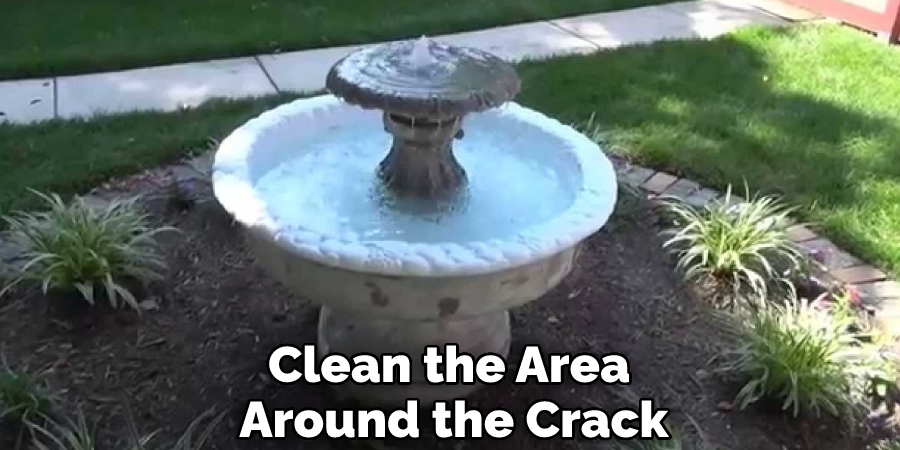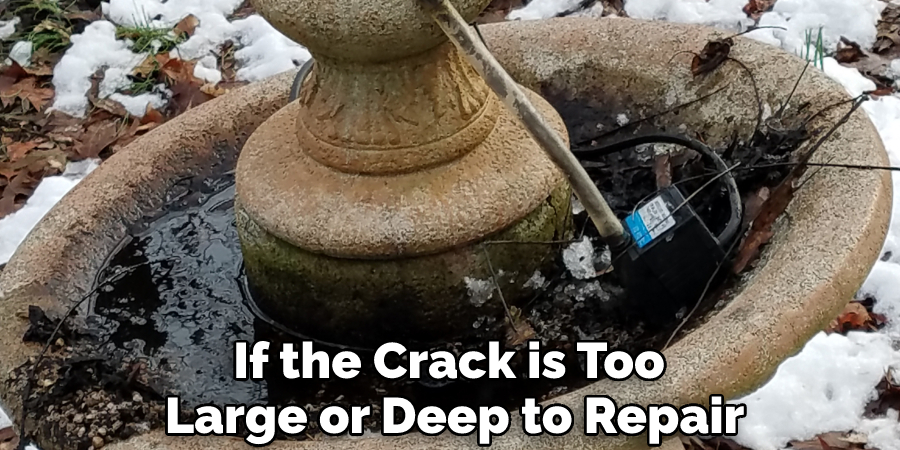Even the best-made fountains can develop cracks in the resin over time. Although it might seem like a discouraging setback, these repairs are actually quite easy to make and can be done with just a few simple tools. This blog post will show you how to fix a cracked resin fountain quickly and easily. Read on for instructions!

Summary: Fixing a cracked resin fountain can be quite a challenge. However, there are certain steps that can be followed to ensure the process is done properly. First, clean the area around the crack with a mild detergent and water.
Then, allow it to dry before applying a repair compound over the cracks. If necessary, sand down or grind away excess material before adding more repair compound. Finally, let the compound dry and smooth out any bumps before sealing it with sealant or paint to protect it from further damage.
What Causes Cracks in Resin Fountains?
There are a few different reasons that cracks can develop in resin fountains. The most common cause is simply age and wear and tear. As the fountain ages, the resin will slowly start to degrade and become brittle. This can cause cracks to form, especially if the fountain is made of thin resin.
Another common cause of cracks is sudden temperature changes. The resin can crack if the fountain is exposed to extreme cold or heat. This is more common with outdoor fountains but can also happen to indoor fountains if they are near a heat source or drafty window. Additionally, if the fountain is moved from a cold location to a warm one (or vice versa) too quickly, the temperature change can cause the resin to crack.
The other major cause of cracks is impact damage. If the fountain is hit with a hard object, it can crack the resin. This is most likely to happen with outdoor fountains, but it can also happen to indoor fountains if they are bumped or knocked over. Lastly, if the fountain is made of poor-quality resin, it is more likely to crack over time.
Is it Bad if My Fountain Has a Crack?
It is not necessarily bad if your fountain has a crack, but fixing it as soon as possible is important. If the crack is left unaddressed, it can worsen over time and further damage the fountain. Additionally, water can leak out of the crack and cause water damage to your home.
Another reason to fix the crack promptly is that it can affect the aesthetics of your fountain. Even a small crack can mar the look of an otherwise beautiful fountain. Finally, if the crack is large or in a visible location, it can be dangerous. Someone could easily cut themselves on the sharp edge of the crack.
Step by Step How to Fix a Cracked Resin Fountain
1. Clean the Area
The first step in repairing a cracked resin fountain is to clean the area around the crack. This will help you see the crack more clearly and remove any dirt or debris that could interfere with the repair. To clean the area, first, remove any water from the fountain. Then, use a soft cloth to wipe away any dirt or grime. You can use a mild soap and water solution if the area is very dirty. Be sure to dry the area thoroughly before proceeding to the next step.

2. Inspect the Crack
Now that the area is clean, you can look closer at the crack. First, determine how deep the crack is. You can probably repair it with a simple patch if it is only surface-level. However, if the crack is deeper, you will need to use a filler to repair it. You should also take a look at the edges of the crack. If they are jagged, you must smooth them out before proceeding.
3. Use a Putty Knife
If the crack is surface-level, the next step is to remove any old resin from around the crack. This will help the new resin to adhere properly to the surface. Use a putty knife or another sharp object to scrape away the old resin. First, insert the blade into the crack and then run it along the edges of the crack. Once you have removed all of the old resin, use a clean cloth to remove any residue. Be sure the area is completely clean before proceeding.
3. Apply Epoxy Resin
If the crack is deeper, you must fill it with epoxy resin. Epoxy resin is a strong, durable material that can be used to fix several different types of damage. It is available in two parts that must be mixed together before use. Once it has been mixed, it will harden quickly, so you must work fast. First, clean the area around the crack with a piece of sandpaper. This will help the epoxy resin to adhere better.
Then, mix the two parts of the epoxy resin together and apply it to the crack. Finally, use a putty knife to smooth it out and ensure it is evenly distributed. Allow the epoxy resin to harden for at least 24 hours before proceeding to the next step.
4. Use Super Glue
If the crack is small and surface-level, you can try repairing it with super glue. Super glue is a strong adhesive that can be used on many different materials, including the resin. To use super glue to fix your cracked fountain, start by cleaning the area around the crack with a damp cloth. Then, apply a small amount of super glue to the crack and spread it evenly with a toothpick.

Finally, press the two fountain pieces together and hold them in place until the glue dries. Try not to move the pieces too much, as this could cause the glue to come loose.
5. Patch the Crack
If the crack is larger, you may need to patch it with a piece of resin. To do this, first, clean the area around the crack with alcohol. Next, apply a thin layer of resin to the patch area with a putty knife. Then, place the patch over the crack and press it into place. Finally, apply a thin layer of resin over the top of the patch. Allow the patch to dry for 24 hours before using the fountain. If the crack is smaller, you can apply a thin layer of resin over top of it. Allow the repair to dry for 24 hours before using the fountain.
6. Fill the Crack
If the crack is too large to be patched, you must fill it with resin. It is best to use a two-part epoxy resin for this purpose. First, mix the resin according to the instructions on the package. Next, use a putty knife to apply the mixture to the crack. Then, use a wet rag to smooth out the surface. Allow the resin to dry for 24 hours before continuing. You may need to repeat this step if the crack is still visible.
7. Use a Resin Repair Kit
If you cannot repair the crack with the methods described above, you may need to use a resin repair kit. These kits contain everything you need to patch up a cracked resin fountain, including the resin itself, hardener, mixing tools, and instructions. First, clean the area around the crack with isopropyl alcohol to use a resin repair kit. Then, mix the resin and hardener according to the instructions included in the kit.
Once the resin is mixed, apply it to the crack using the supplied applicator tool. Finally, allow the repair to cure for the amount of time specified in the instructions.
8. Replace the Fountain
If the crack is too large or deep to repair, you may need to replace the fountain. This is typically a last resort, as replacing a fountain can be expensive. If you do need to replace the fountain, make sure to get one that is made of durable materials that can withstand the elements. When shopping for a new fountain, look for one made of resin. Resin is a durable material that is resistant to cracking and chipping.

It is also easy to clean and maintain. You may also want to consider a fountain made of concrete or stone. These materials are also durable and easy to maintain. If you have a small budget, you may want to consider a plastic fountain.
Tips and Warnings on How to Fix a Cracked Resin Fountain
Tips:
- Be sure to clean the area around the crack before trying to repair it.
- If you are using super glue to repair the crack, be sure to apply a thin layer. Too much glue can cause the pieces to come apart.
- If you use resin to repair the crack, mix it well before applying it.
- Apply the resin or glue in a well-ventilated area.
- Allow the repair to dry completely before using the fountain.
Warnings:
- Do not use super glue on an outdoor fountain, as it will not withstand the elements.
- Do not use resin on an outdoor fountain as it will yellow in the sun.
- If you are unsure about repairing, consult with a professional.

Frequently Asked Questions
Can You Repair a Cracked Fountain?
While it is possible to repair a cracked fountain, this may not be the best solution. A better option would be to replace the fountain altogether. Cracked fountains can lead to water damage and eventually failure of the pump or other components that are connected to it. Replacement fountains are often more durable and tend to last longer than repaired ones.
What Do You Use to Seal a Water Fountain?
When it comes to water fountains, you want them to last as long as possible without any problems. To ensure this, you should seal the fountain using a sealant or wax. Sealing the fountain can prevent dirt and debris from accumulating which can cause rusting and deterioration of the hardware over time.
Some popular sealants or waxes that are suitable for use with water fountains include silicone caulk, zinc oxide varnish, carnauba wax, beeswax polish, mineral oil polish, and polymerase chain reaction (PCR) primer/sealer liquids. You will need to test out a few different options before settling on one that fits your specific needs and preferences.
Once you have selected the right sealant or wax, follow these simple instructions to apply it: 1) clean all parts of the water fountain thoroughly; 2) remove all flammable materials such as a plastic wrap, etc.
Is There a Sealant That Can Be Applied Underwater?
Yes, there is a sealant that can be applied underwater! This is a great option for those who want to protect their pool or spa from seasonal damage. The sealant is water-resistant and will protect the pool or spa from dirt, leaves, and other debris. It can also help to preserve the color and texture of the pool or spa.
Will Flex Seal Work Underwater?
Unfortunately, Flex Seal will not work underwater. The sealant is designed to be used on surfaces that are accessible and dry, such as wood or metal.
Conclusion
So there you have it! Everything you need to know about how to fix a cracked resin fountain. Following this article’s tips and instructions, you can easily repair your fountain and get it back in working order. If you have any questions or comments, please feel free to leave them below. Thanks for reading!
